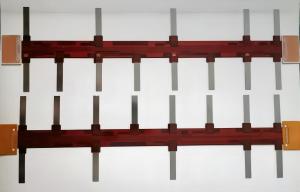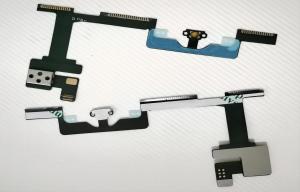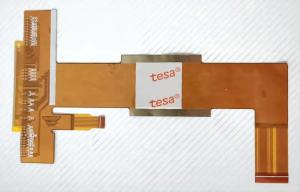Greathome focused on manufacturing single-sided FPC, double-sided FPC, multilayer FPC, Rigid-flex PCB, Metal Core PCB, and so on all kinds of PCB products, widely used in LED lighting, New energy battery, Wireless communications equipment, High-end equipment display, Digital camera, Computer and accessories, Smartphone, Smart wearable devices, Automotive electronics, 5G, AR/VR and other industries, we can meet the customized production and PCBA processing (Or finished product assembly) needs of all kinds of products.
If you are looking for a reliable flexible PCB board partner in China, please don’t hesitate to contact us.
What are the available types for flex PCBs?
There are numerous, different structures available. The more common ones are defined below:
Single sided flex (IPC-6013 type 1) Coverlay (polyimide + adhesive) bonded onto an adhesiveless single sided FPC core. With or without stiffeners.
Double sided flex (IPC-6013 type 2) Coverlay bonded onto both sided of an adhesiveless double-sided FPC core (two conductive layers) with plated through holes. With or without stiffeners.
Multilayer flex (IPC-6013 type 3) Coverlay bonded on both sides of an adhesiveless construction containing three or more conductive layers with plated through holes. With or without stiffener.
Our current Multilayer Flex PCB manufacturing capability is up to 12 Layers.
What is a flexible PCB board?
FPC is an acronym for Flexible Printed Circuit, Also called Flex(also called soft board, FPC board), that is, a flexible printed circuit board. it is a kind of pcb, with excellent flexibility.
FPC is a foldable printed circuit board that forms a circuit on a copper foil with PET or PI as the base material, which is light and thin, high density, high flexibility, bendable and foldable, and has advantages that other types of circuit boards do not have. It can properly carry a variety of active and passive components and accessories. Through appropriate assembly design, it is widely used in The modules of the electronic product are connected to each other.
Compared with traditional interconnection technology, FPC flexible circuit boards can withstand millions of bending times, are easy to install, and have good heat dissipation, which are favored by the market.
FPC circuit board can complete the overall wiring work on one machine, which can be expanded and moved arbitrarily according to the space layout requirements, reduces the wiring volume, realizes the integration of component assembly and wire connection, and promotes electronic products to be smaller, lighter and thiner.
Advantages of flexible PCB boards
Flexible PCB boards are printed circuits made of flexible insulating substrates, and have many advantages that rigid PCB boards do not have:
1. It can be bent, wound, and folded freely, can be arbitrarily arranged according to the space layout requirements, and can be moved and expanded in three-dimensional space, so as to achieve the integration of component assembly and wire connection;
2. The use of FPC board can greatly reduce the volume and weight of electronic products, which is suitable for the development of electronic products in the direction of high density, miniaturization and high reliability. Therefore, FPC has been widely used in aerospace, military, mobile communications, laptop computers, computer peripherals, PDAs, digital cameras and other fields or products;
3. Flexible pcb board also has the advantages of good heat dissipation and solderability, easy assembly and low overall cost, etc. The design of Rigid-flex PCB also makes up for the slight deficiency of the flexible substrate in the component carrying capacity to a certain extent.
How to design a flexible PCB board?
When designing a flexible circuit, it is important to understand the specific application of the flexible PCB board. Can it be used in a static or dynamic environment?
If the FPC board is to be placed in a static environment with little movement, the circuit design needs to have appropriate flexibility so that it can be easily installed in the product. Or, if the board is to be placed in a dynamic environment (in which the board will continuously bend back and forth), the flexibility to withstand continuous motion needs to be considered in the design.
Unlike rigid circuit boards, flexible PCB boards have many variations, so it is very important to have detailed manufacturing drawings to accompany the design. The manufacturing drawing should mark all details, so the manufacturer should not ignore it. The worst thing is to let the manufacturer take care of your requirements. Flexible circuits have many moving variables, so details are very important.
What is the structure and composition of the flexible PCB board?
1. CCL (Copper Clad Laminate)
CCL is composed of three layers of Copper foil + Adhesive + Substrate, and there is also no glue substrate, that is, Copper foil + Substrate two layers of combination, its price is higher, suitable for bending life requirements of more than 100,000 times on the product.
A. Copper foil
From the material , it can be divided into Electrolysis Desposition Copper Foil (ED Copper Foil) and Roll Anneal Copper Foil (RA Copper Foil) according to the production method. In terms of characteristics, Roll Anneal Copper Foil has better mechanical properties, and most of us choose Roll Anneal Copper Foil when making products with higher requirements on flexible/bending.
Copper Foil thickness is generally divided into 1/3 oz, 1/2 oz, 1 oz, 2 oz and other four types.
B. Substrate
Substrate is divided into PI Film and PET Film. The price of PI is higher, but its fire resistance is better, while the price of PET is lower but not heat resistant. Therefore, if there is a need for welding, PI materials are almost used. The thickness of the substrate is generally 1/2mil, 1mil, 2mil.
C. Adhesive
There are two types of Adhesive: Acrylicf and Epoxy. The most commonly used is Epoxy, Thickness: 0.4-2mil, Adhesive with a thickness of 0.7mil is commonly used.
2. Coverlay
Coverlay is composed of substrate+Adhesive, and its substrate is PI and PET two types, Thickness: 0.5-1.4mil.
3. Stiffener
- Function:
In the local area of FPC, in order to facilitate welding parts, Adding Stiffener for install and compensate the thickness of FPC.
- Material : PI/PET/FR-4/Steel.
- Combining with the way: PSA(Pressure Sensitive Adhesive) : Pressure sensitive type (e.g. 3M series) Thermal Set: Thermal setting (binding strength, solvent resistance, heat resistance, potential resistance, etc.)
What is the difference between flexible PCB board, Rigid PCB board and Rigid-flex PCB board?
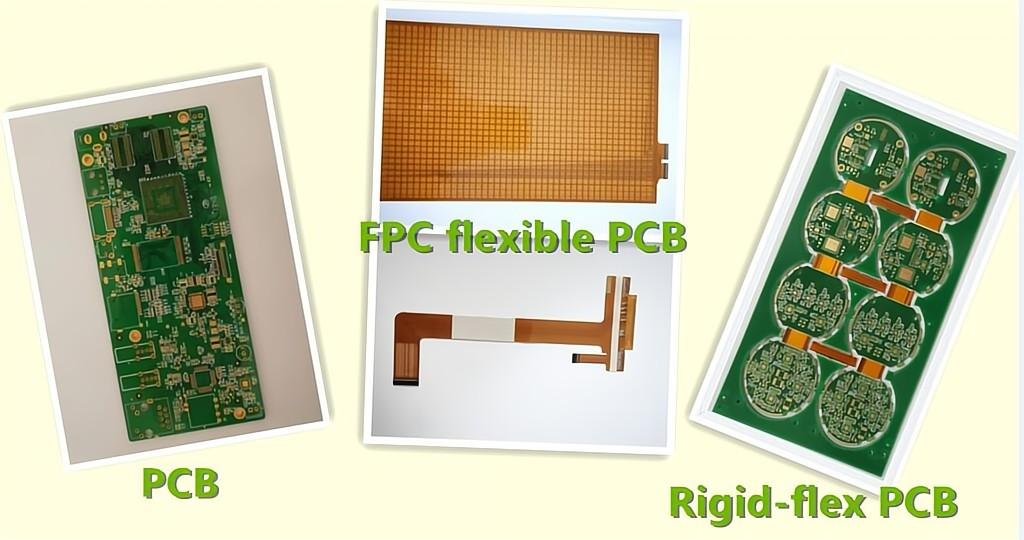
Flexible PCB boards play an important role in the lead-free operation, but they are currently costly, but they are slowly reducing costs. Generally speaking, flexible PCB boards are indeed more expensive and costly than rigid PCB boards. When manufacturing flexible PCB boards, in many cases have to face the fact that many parameters are outside the tolerance range. The difficulty in manufacturing flexible PCB board lies in the flexibility of the materials.
The rigid-flex board has the characteristics of FPC board and rigid PCB board at the same time. Therefore, it can be used in some products with special requirements. It has both a certain flexible area and a certain rigid area, which can save the internal space of the product. It is a great help for reducing the volume of the finished product and improving the performance of the product. It is commonly used in mobile phones, Digital camera, Healthy Electronics, Intelligent wear etc.
However, there are many production processes for the rigid-flex PCB board, the production is difficult, the yield rate is low, and more materials and manpower are used. Therefore, its price is relatively expensive and the production cycle is relatively long.
How to make the flexible PCB board?
1 layer FPC PCB Manufacturing process: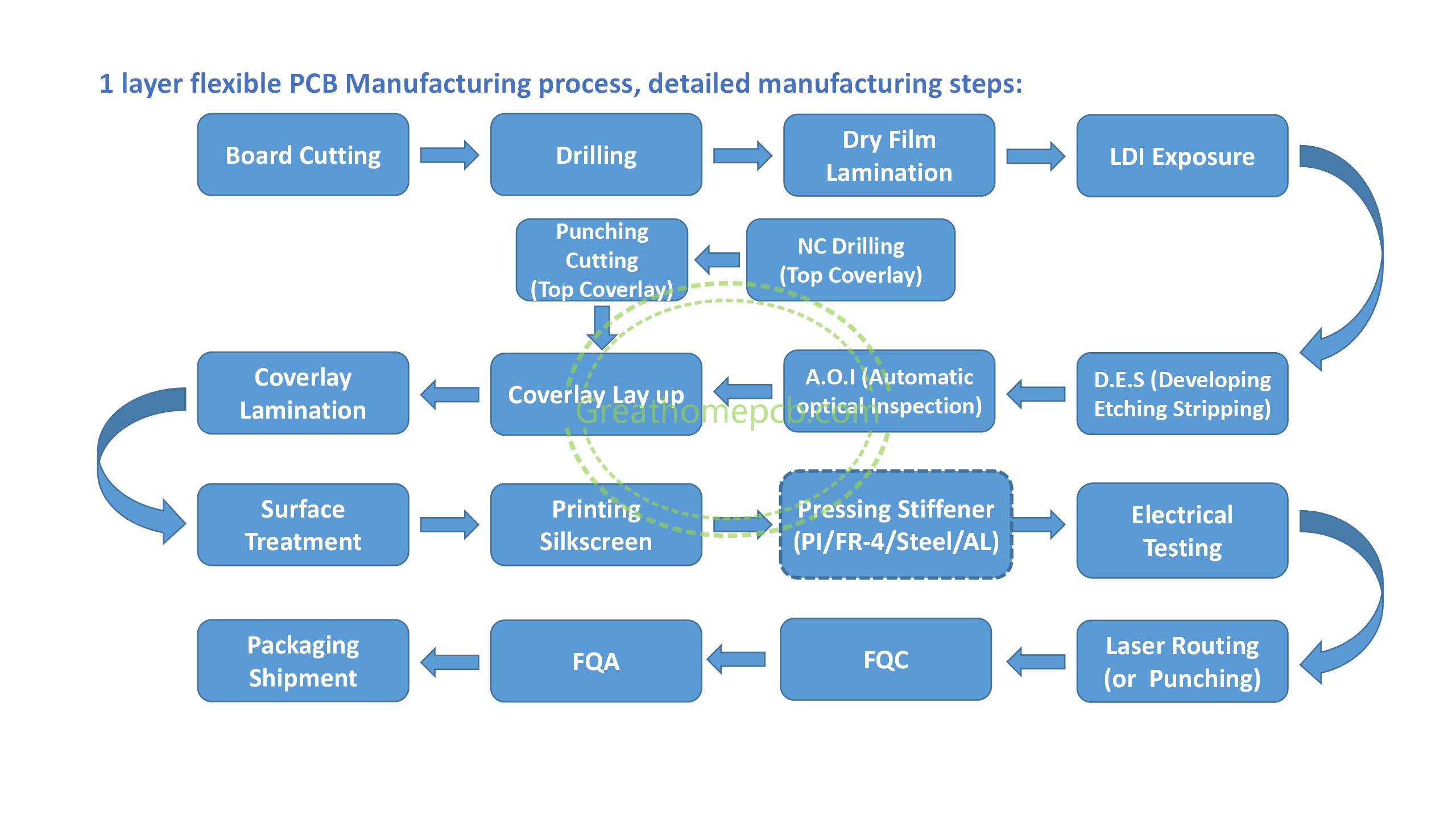
2 layers FPC PCB Manufacturing process: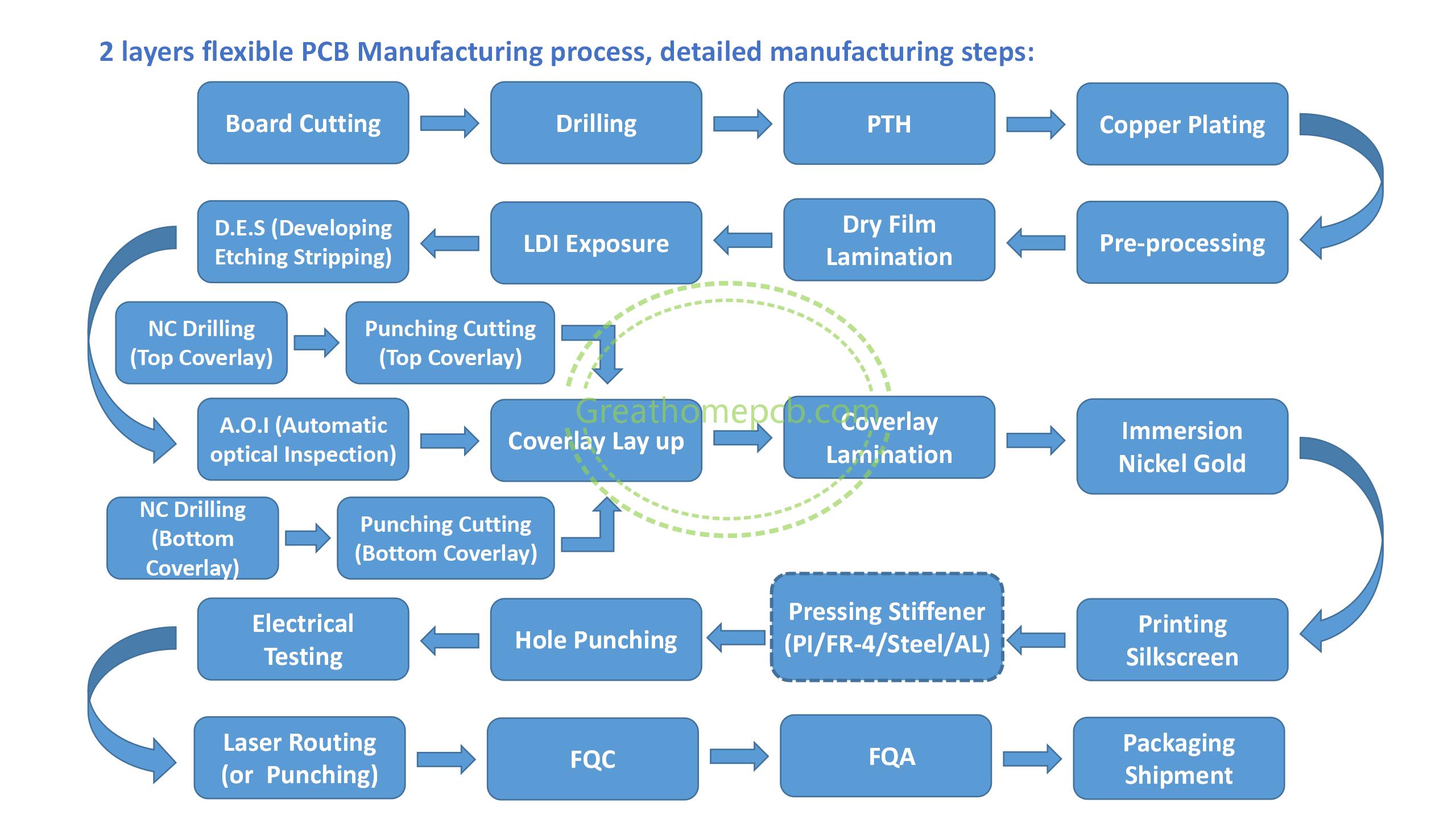
Multi-Layer FPC PCB Manufacturing process: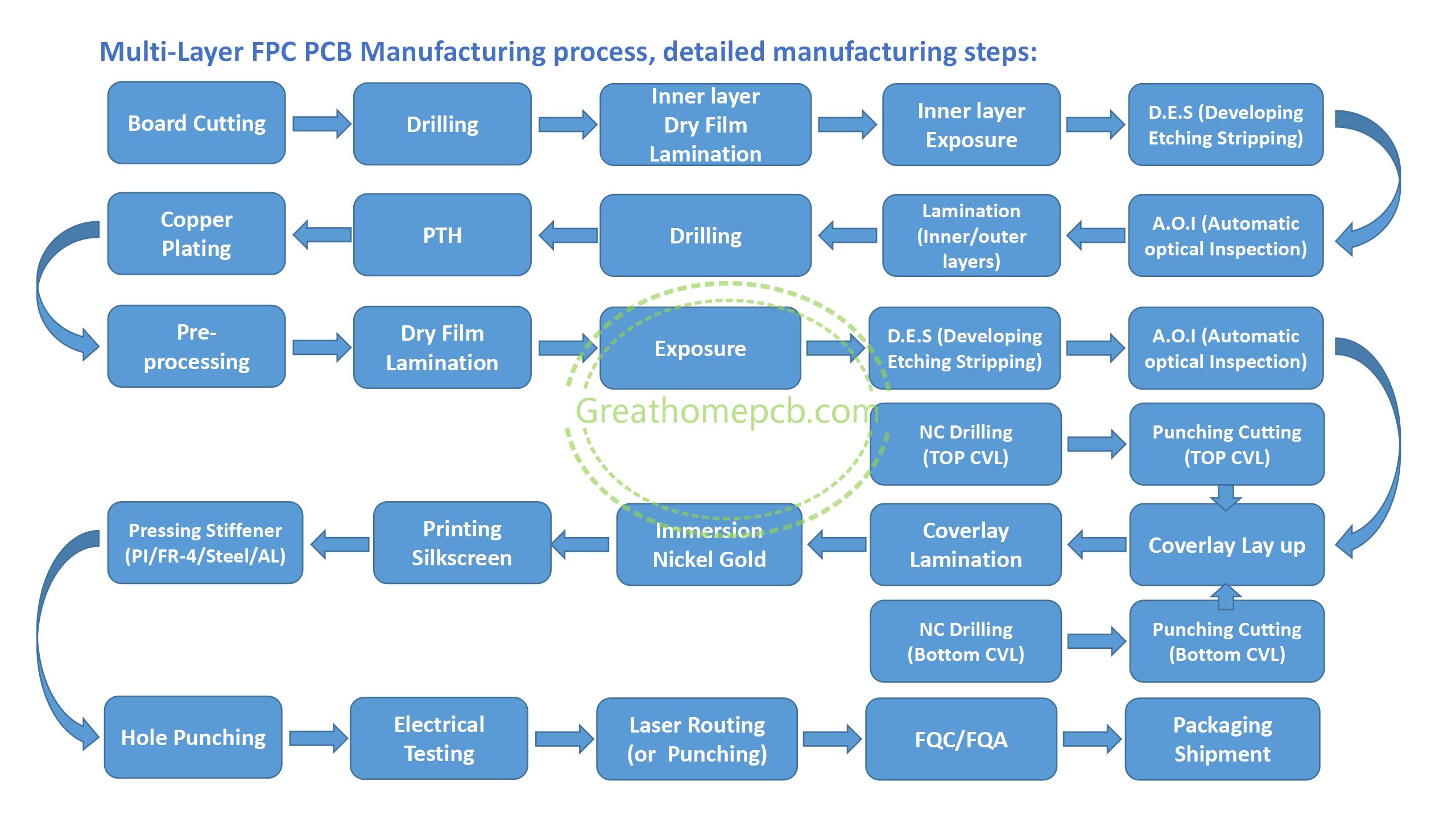
Whether it is 1 Layer FPC, 2 layers FPC, multi-layer FPC or Rigid-flex PCB, we will R&D and Design(ODM) the Manufacturing process(MI) of each PCB board according to customers' requirements and product characteristics to meet customers' requirements and IPC standards.
It doesn't matter if your design or process specifications are not perfect, our engineers will give us reasonable suggestions and plans in the pre-manufacturing engineering design stage, and we will work together to meet the best performance and best PCB products.
Application of FPC flexible circuit board
FPC flexible circuit boards account for a large proportion of applications in smart phones, which can meet the needs of mobile phone screens, batteries, and camera modules. In the 5G era, the emergence of multifunctional smart phone modules, radio frequency modules, folding screens, and miniaturized models are inseparable from the connection of FPC flexible circuit boards. Therefore, in the development of smart phones, the amount of FPC flexible circuit boards is also constantly improving.
With the development trend of miniaturization of smart terminals, FPC flexible circuit boards are light and flexible, making them more and more important during manufacturing of smart wearable devices. As one of the main materials of smart wearable devices, FPC flexible circuit boards have a broad market development space. It is expected to continue to rise in the future and become a beneficiary of the development of smart wearable devices.
In addition to consumer electronic products, the application of FPC flexible circuit boards also covers many fields such as automobiles, medical treatment, and industrial control, and the application prospects are very broad.


